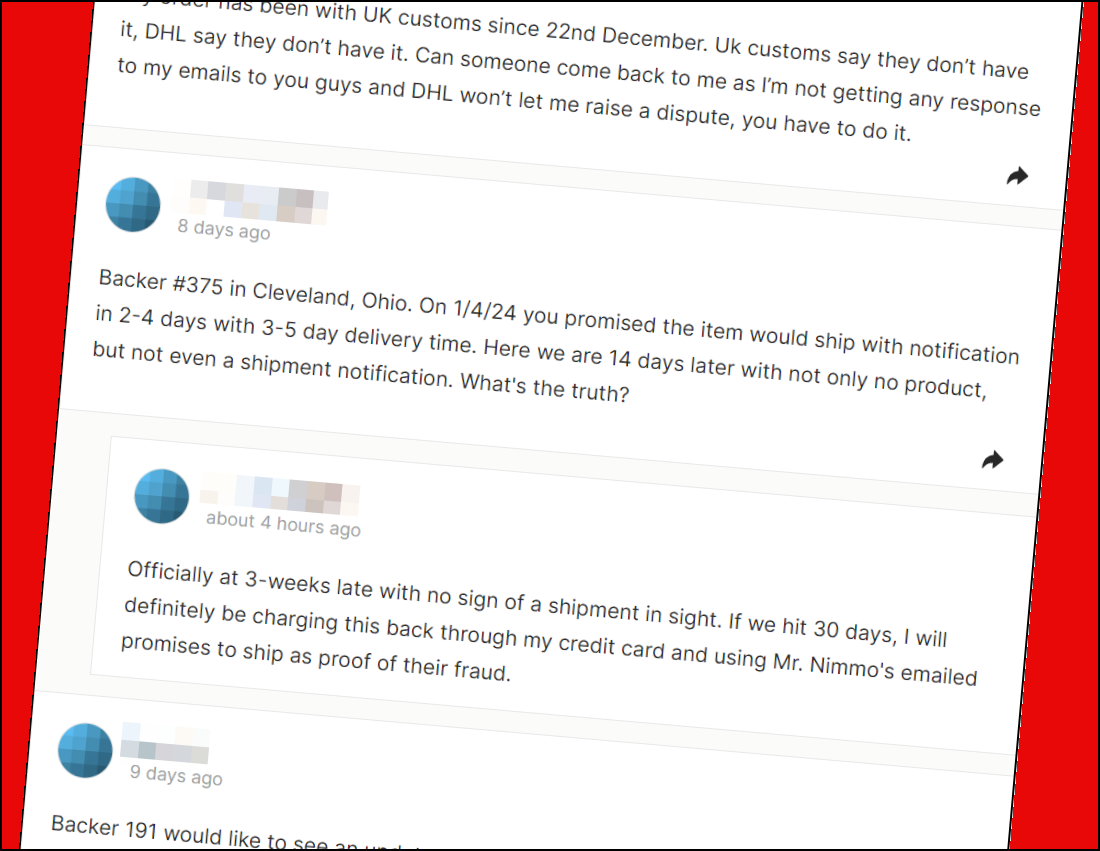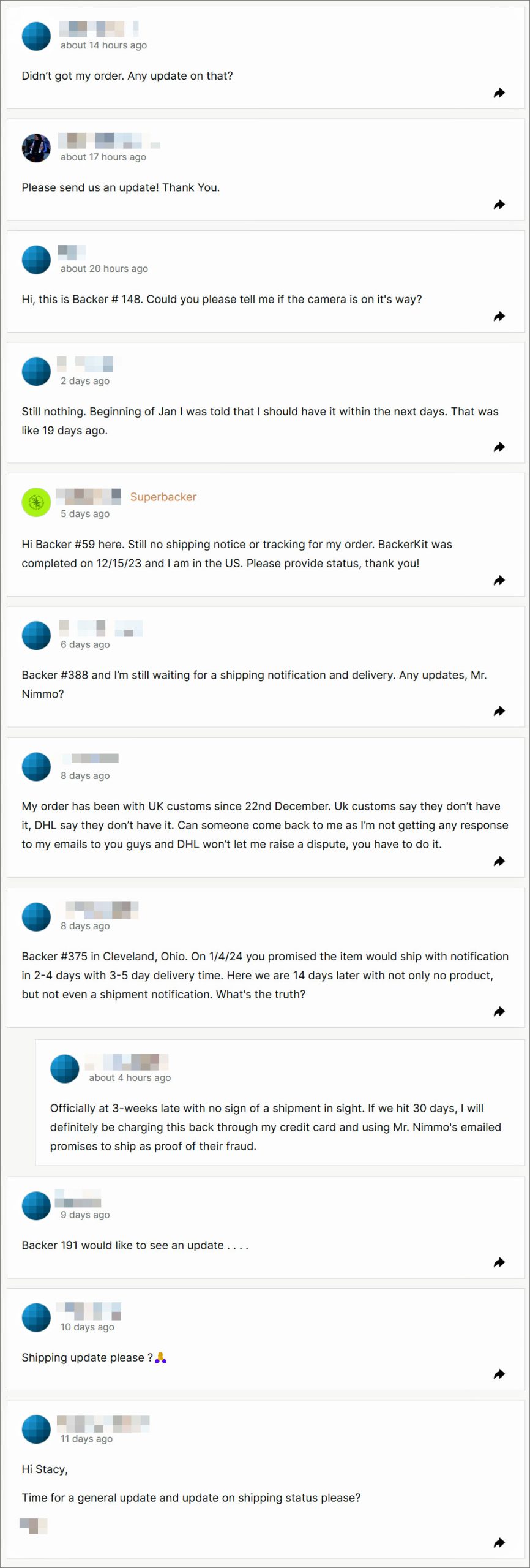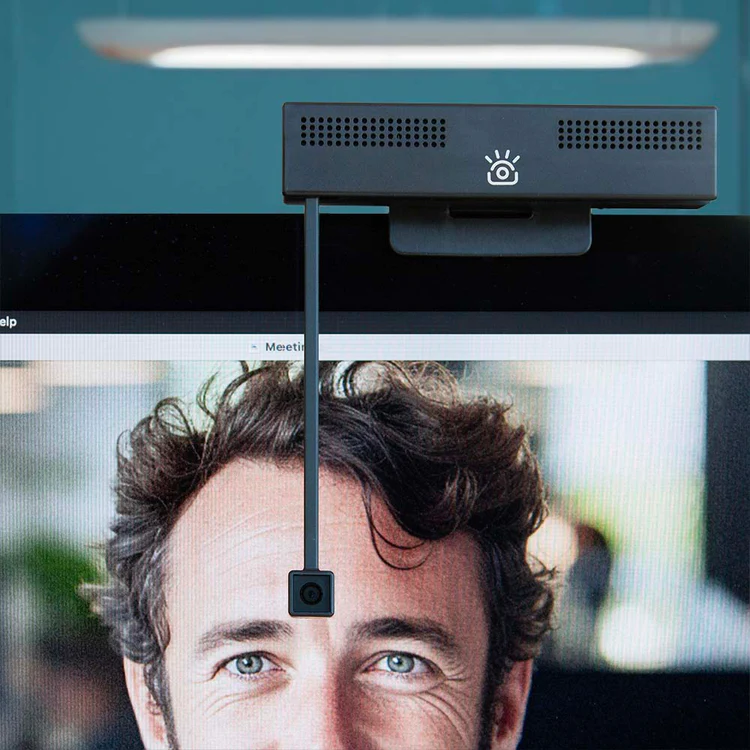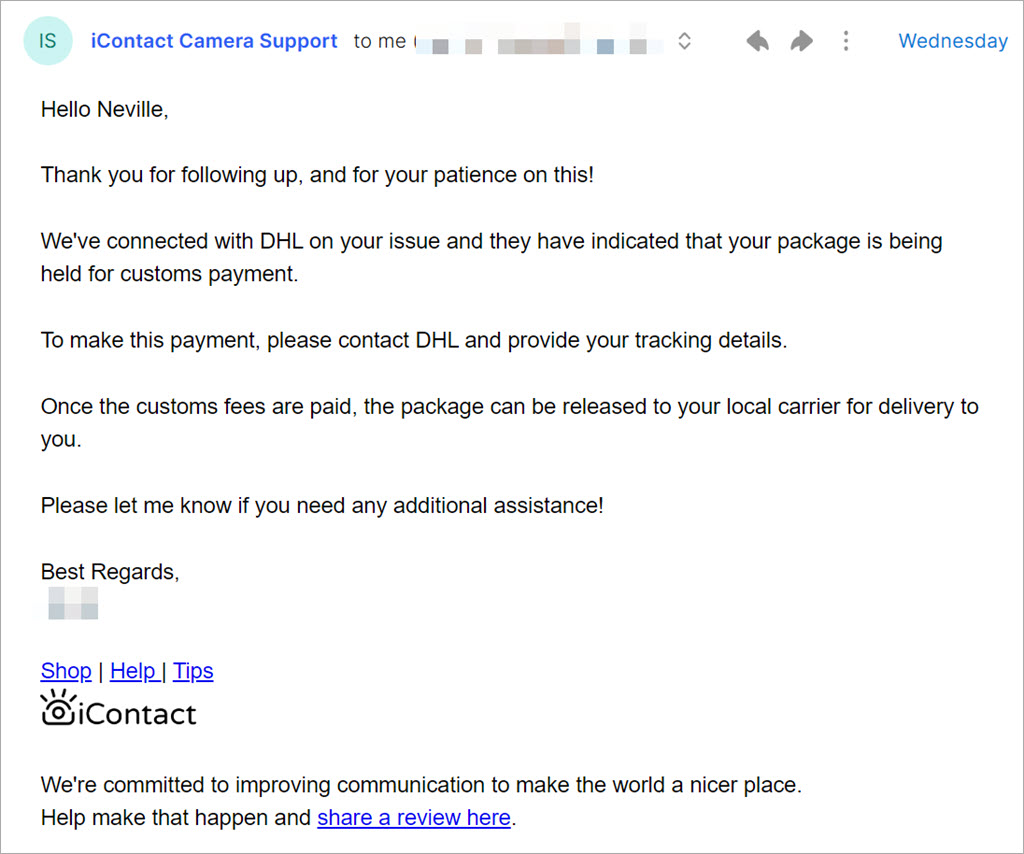Updated 18 March 2024.

Not long after I posted my late-January update, I learned from iContact Support that they and DHL had concluded that my package had been “lost in UK customs.” I engaged in an email discussion with iContact Support and accepted their offer to ship a replacement camera free of charge instead of requesting a refund. In spite of my misgivings about their history to date, I decided to give it one more shot.
They told me the new camera would arrive in February but it actually arrived in mid-March. Another unmet expectation, but this time there was no customs involvement. I posted a first-look review on 18 March.
Would I do business again with iContact the company? Well, as I said in that post, I’m keeping an open mind about iContact the company for now. As for the webcam, my initial view, as would be clear from my first-looks video, is that they have an excellent product.
Updated 26 January 2024.
Since publishing my initial experience with the iContact Camera Pro Kickstarter campaign on January 19, 2024, appended below, I regret to inform readers that the situation has not improved; in fact, it has deteriorated further.
Despite my hopes for a turnaround or at least some form of communication from Stacy Nimmo, the project creator, there has been a conspicuous absence of any updates or responses. As someone who values clear and authentic engagement, this lack of communication is particularly disheartening.
It’s now been five weeks since the DHL tracker reported that the package had arrived in UK customs at Heathrow Airport. Yet, my package remains undelivered with no meaningful information provided about its status other than an email from iContact Support on 17 January telling me that DHL had “indicated that your package is being held for customs payment.”
Since then, complete silence. No information from anyone about a customs payment (I asked iContact Support for information on the amount and how to pay it), just more silence.
Moreover, I’m not alone in this experience. A growing number of backers have taken to the Kickstarter page to voice their concerns and request updates. These inquiries, much like mine, have gone unanswered. Many are in the US, where international shipping and customs issues don’t arise. This silence from the creator not only adds to the frustration but also raises serious questions about the integrity of the campaign and its management.

Indeed, I see at least one backer has used the word “fraud” in his comment.
Last week, I wrote a private message via Kickstarter to Stacy Nimmo requesting that he respond and post an update on the campaign page to give all backers some reassurance about the campaign, their investments and the campaign promise of giving backers a product as a perk if the fund-raising campaign succeeded which it clearly did.
After all, the campaign had received over $305,000 in pledges from backers on Kickstarter by mid-December, averaging a bit under $200 each. Much of that would have been paid to iContact so that perks could be shipped. There is also nearly $170,000 from an earlier IndieGogo campaign for the first-generation webcam. That campaign page also references $147,000 received from “another platform.”

But, no reply from Stacy Nimmo.
I had hoped to share a different narrative at this point – one of resolution and positive engagement. Sadly, that’s not the case. Therefore, it felt necessary that I provide this update to maintain the authenticity and trustworthiness of my content.
I will continue to monitor the situation and update this post should there be any developments. I’ll also continue commenting on my LinkedIn page and on Threads.
For those considering backing projects on Kickstarter, this experience serves as a reminder of the inherent risks and the importance of due diligence.
Original post published on 19 January 2024:

In the ever-evolving landscape of technology, the allure of cutting-edge products often leads us to funding platforms like Kickstarter and Indiegogo. It’s here that innovative ideas find support and backing, transforming them from mere concepts into tangible realities.
My journey with iContact, a promising startup with new webcam technology, began with a similar enthusiasm. As a backer of its second-generation iContact Pro camera on Kickstarter, not only did I contribute to the birth of a potentially groundbreaking gadget, but I was also promised to be among the first to receive it – a perk that added to the appeal of this venture.
However, as is sometimes the case with the unpredictable nature of crowdfunding and international shipping, my experience took an unexpected turn just before Christmas.
The product, shipped via DHL from the US in mid-December, vanished into the complexities of international logistics, getting stuck in UK customs at Heathrow Airport, London, since December 22.
Almost a month later, there it still apparently languishes.

The core of my disappointment does not lie with the product itself, which I am yet to receive, but with the opaque curtain that has fallen over the communication channels and customer service. Both iContact and DHL have been less than forthcoming with information regarding the status of my shipment and when I might expect to receive it.
Customer Service Sorely Lacking
DHL seems to go out of its way to make it near-impossible to find which part of DHL is the right part to talk to, and makes you start with a chatbot. If ever there were a more depressing experience in customer service, it’s trying to engage with a chatbot that’s the first line of a company’s customer service structure (perhaps they see it as “the first line of defence”).
Eventually, I did connect by phone with a helpful customer service agent in some far-flung corner of DHL’s global infrastructure who gave me a phone number for HMRC, the UK government tax and customs authority, to call about this as the agent thought my package might be stuck because of a pending customs charge. She added, though, that this should be something the sender (ie, iContact) should be doing, not me.
Four attempts at calling HMRC, and trying to get past the auto-menu system with so many multiple choices to a human, have proven fruitless so far.
iContact support sends me cheery emails in response to my inquiries but without useful or even meaningful information. It’s clear to see their position when they use words like “your issue” when they reference the DHL and customs situation.
But, to be fair, they said they did get in touch with DHL to learn that, yes, there is a pending customs charge and that I should pay it which would then release the package.

It’s a pity, though, that the email lacked some useful information such as the amount to pay and contact information at DHL. Given the amount of time that’s now passed, I wouldn’t be surprised to learn that the package has been returned to the sender as the customs charge hasn’t been paid.
I’ve also been asking questions in comments on the Kickstarter page; the only meaningful response is from another backer in the UK who has experienced a similar issue to the one I’m writing about.
And, to add insult to injury, I keep getting marketing emails from iContact asking me to review the product. There’s a big disconnect there!
It’s a Long Story
I’ve backed a number of startup projects on Kickstarter and Indiegogo over the years. This is my first bad experience.
In the information iContact have on their Kickstarter page, they say that they have 71 backers in the UK for this project. Perhaps the other backer I mentioned earlier and I are the only ones in the UK who have had such a poor experience as I’ve not seen anyone else talking about this.

In which case, if I donned a marketing hat, I suppose you could argue that a 2.82 percent failure rate (2 out of 71) in customer service – this is what this is about, after all – is quite acceptable. (Personally, I’d say anything more than 1 percent is wholly unacceptable, but that’s just me talking as a customer.)
I do wonder how the other 69 backers in the UK have fared. Have some or all encountered this as well?
I paid $178 including shipping to iContact to back this project, and I’ve not yet seen the perk I expected as a direct return on this investment. Now I belatedly learn there’s a customs fee to pay in addition, amount unknown. I’m not complaining about the customs charge – it’s quite clear on the Kickstarter page that there might be such a charge to pay. What I strongly object to is the lack of any information about why my package is stuck in customs, and then after weeks, it’s like “Oh, yes, there’s a customs fee to pay; get in touch with DHL to pay it.”
Should I just write this investment off and put it down to (bad) experience and caveat emptor?
Whatever the eventual conclusion of my story, I have these concise takeaways from this journey to note:
- The Risks of Crowdfunding: There are inherent risks associated with backing crowdfunding projects, such as delays and unanticipated challenges, and the importance of having realistic expectations.
- Importance of Communication: Effective communication from companies, especially in situations involving delays or complications, is absolutely critical. It underscores the need for transparency and proactive updates from businesses to maintain trust with their backers.
- Navigating International Shipping Complexities: Without question, this has been an unexpected and major hurdle. I aim to be better prepared next time to understand the challenges of international shipping, including customs delays and logistical issues, and the importance of being prepared for these potential obstacles when backing international projects.
My purpose in writing this post is to shed light on the risks and realities of backing crowdfunded projects, particularly focusing on the communication challenges and logistical hurdles that can arise in the process.
It’s a tale not of anger, but of disappointment and the silent questions that linger in the absence of proactive meaningful responses from the companies we trust with our investments and expectations.











